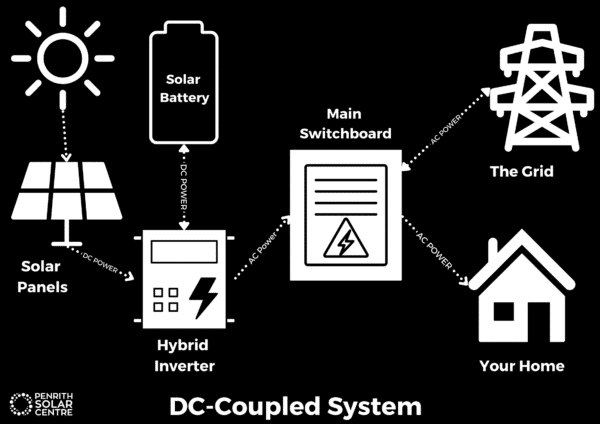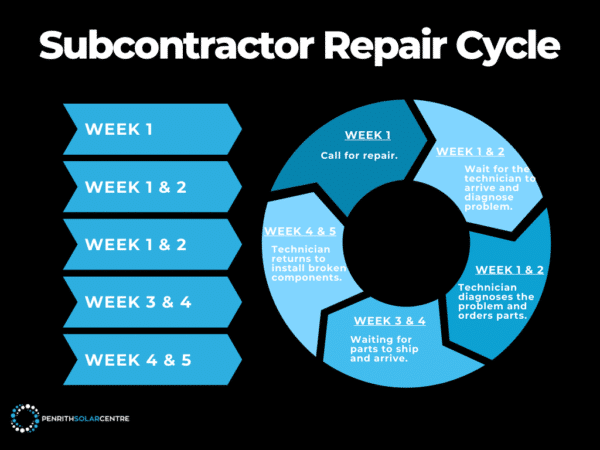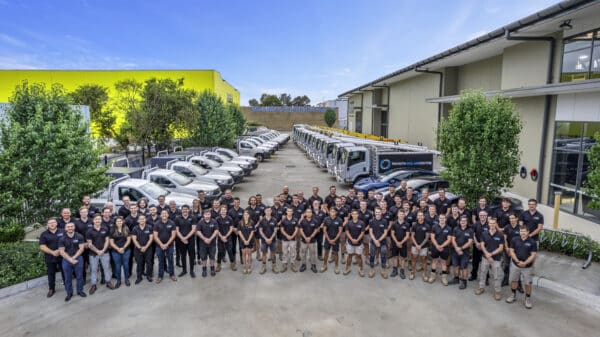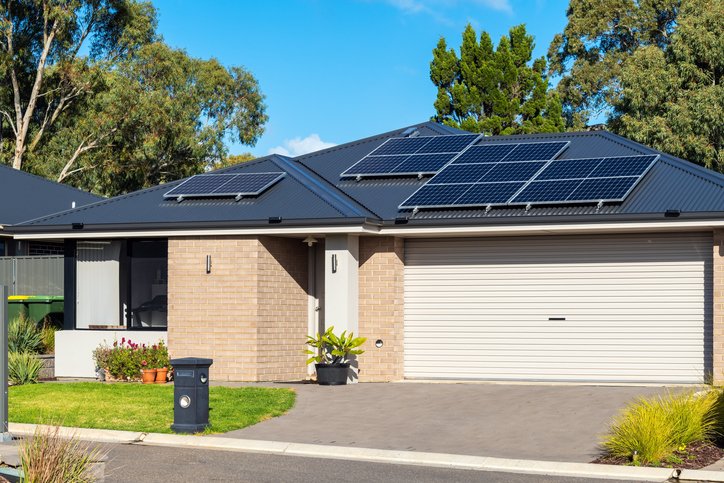
It doesn’t matter what you’re shopping for, the cost is the most important question you have. For Tesla’s Powerwall 3, the answer isn’t straightforward.
You can find a clear-cut price on Tesla’s website for Powerwall 3. But that’s just for the equipment (which is $11,900 for the battery and $1,700 for the Backup Gateway, a compulsory piece of equipment. When you add them together, you get $13,600).
But that price tag is for the hardware alone. You’ll also need to consider installation costs and potential upgrades to your home or solar system. All of this makes understanding the true cost a little more complex.
The good news? Penrith Solar Centre is installing the Powerwall 3. It offers more value than any other solar battery in its class on the market when paired with solar. It combines a hybrid inverter, battery storage, and smart features all in one unit. We’re here to walk you through its price and value.
In this article, you will learn the following:
- Installing Powerwall 3 as a New Solar System
- Adding Powerwall 3 to an Enphase System or an Existing Solar System
- How Much Does a Powerwall 3 Cost at Penrith Solar Centre?
By the end of this guide, you’ll know exactly what questions to ask to get the best deal on Powerwall 3.
Installing Powerwall 3 as a New Solar System
The wonderful thing about Powerwall 3 is its versatility. It can be installed in different ways to best suit your needs.
When installing Powerwall 3 with solar panels at the same time, you will use the enclosed DC hybrid inverter. The Powerwall 3 will allow up to 20 kilowatts (kW) of panels to be DC-coupled to the battery.
We won’t go too technical into the wiring itself here, we just want you to understand why there are different installation options and why you have choices. How a solar battery is wired into a system informs how that system will work and how much that system will cost.
So then, what is a hybrid inverter, and what does DC-coupled mean?
Hybrid Inverter: Solar panels harvest sunshine and generate electricity in the form of direct current (DC) power. But homes run on alternating current (AC) power. The DC power needs to be converted to AC power. This is what the hybrid inverters do. They change the waveform of electricity so it’s usable for the home.
Powerwall 3 has an integrated hybrid inverter within the battery casing. This means that two components of a solar system are installed as one. Battery + hybrid inverter.
DC-coupled: When we say the Powerwall 3 is “DC-coupled,” we’re referring to how the battery is wired to the home and solar system. It’s kind of technical. If you’re interested in learning more about what a DC-coupled battery is, you might want to check out the following article titled, AC-coupled Battery vs. DC-coupled Solar Batteries.

Power from the panels goes into the Powerwall 3 without conversion because the input from the roof bypasses the enclosed hybrid inverter. And then the hybrid inverter outputs AC power from the battery to the home or the grid. This creates a more efficient charging and discharging cycle.
Up to 20kW of Solar: The biggest benefit of installing Powerwall 3 as a standalone system is the solar panels we’re bundling with it. It’s an exceptional value that you’ll have trouble finding elsewhere.
Solar panels with a battery offer true energy independence. It’s impossible to produce, store, and consume homegrown electrons without a battery paired with your solar panels on the roof. In our opinion, this is a great value for customers.
200% Oversizing: When you use the hybrid inverter in your battery with DC coupling (as intended), it allows you to oversize your solar system by 200%.
Oversizing your system is more or less what it sounds like. You can increase the number of panels on your roof in relation to the size of your inverter. In this case, 200% power output in relation to the inverter. Powerwall 3’s hybrid inverter is capped at 10kW so you can install up to 20kW of panels on the roof.
Doing this makes you eligible for a larger federal solar rebate. It’s a great practice in general for getting the most out of your solar system, but in this instance, the government facilitates you getting more money when you install solar this way.
The federal rebate is decided by how much electricity those panels will produce or offset from the day you install it to the day the scheme ends in 2030. The larger your system, the larger the rebate. Oversizing the panels with Powerwall 3 increases the system size and your rebate.
If Powerwall didn’t have this 200% oversizing ability (all DC hybrid inverters do this), then the battery would be quite a bit more expensive. The rebate from the government significantly offsets the cost of the system.
Essentially, the cost of the panels is covered by the value of the rebate, making bundling them an exceptional deal.
If you’re interested in learning a bit more about the ins and outs of solar batteries, you might want to start with the following article titled, 7 Considerations for Choosing a Solar Battery.
Adding Powerwall 3 to an Enphase System or an Existing Solar System
Powerwall 3 integrates into the Enphase system as an AC-coupled battery. It connects to the home’s main switchboard, receiving AC power from the Enphase microinverters.
In this setup, your existing solar panels send electricity to your home through a microinverter (if it’s an Enphase system) or a string inverter (if it’s a string system), and the Powerwall 3 connects to each system via AC coupling.

In an Enphase system, the microinverters are mounted individually beneath each solar panel. Electricity is converted from DC to AC by the microinverter, and then again converted from AC to DC to store the energy in the battery. That conversion process is slightly less efficient than DC coupling the battery, which bypasses the inverter and eliminates one of the power conversions. In this type of setup, the hybrid inverter will only be used to charge and discharge the battery.
Pairing an Enphase system with Powerwall 3 will cost more upfront, but the potential efficiencies over time make this option viable as well.
An AC-coupled system doesn’t have a 200% oversizing rule. The oversizing rule for AC-coupled solar is only 33% more panel capacity than inverter capacity. So, for example, if you had 10kW worth of microinverters, the most solar panels you could put on the house would be 13.3kW. The government rebate will be smaller because the system is smaller and unable to generate the same amount of estimated solar energy as a DC-coupled option.
While that might sound like a disadvantage compared to DC coupling the battery, there’s another consideration here: power capacity. AC coupling the battery on an Enphase system gives you immediate access to more solar power.

When you AC couple Powerwall 3, it can discharge 10kW of stored energy without touching the kilowatts coming down from the Enphase system. Let’s say the system is pumping out 10kW via microinverters. You’d be able to draw up to 20kW of renewable energy in this example.
When you DC couple Powerwall 3, you’re limited by the size of the hybrid inverter only, which is 10kW. So, it is much less immediate power to use. So while there’s 20kW bypassing the inverter for efficient charging, the hybrid inverter can only output 10kW at a time.

It’s something to think about if you have a lot of power-hungry appliances, this might be important to you. AC coupling Powerwall 3 gives you more power at a time.
There’s also the issue of whether your home is single-phase or three-phase. That will also inform your decision. It’s quite complicated, but fortunately, we have an article about that too.
Consult with an experienced installer who understands three-phase considerations to ensure that your Powerwall 3 setup works perfectly with your home.
If you’re interested in learning a bit more about installing a single-phase battery like the Powerwall 3 on a three-phase site, you might want to check out the following article titled, Can I Install a Single-Phase Battery on a Three-Phase Home?
How Much Does a Powerwall 3 Cost at Penrith Solar Centre?
The Tesla Powerwall 3 is not cheap, but it will be worth the investment depending on how you plan to use it. If you’re installing a Powerwall 3 as part of a new solar project, the cost is different compared to adding it to an existing solar setup.
Here’s the price breakdown for two scenarios:
- Installing Powerwall 3 with a new solar system (DC-coupled): The cost starts at $23,990. This price includes six kilowatts (kW) of solar panels, but it can go up if you want more solar capacity. You can install up to 20 kW of solar panels with this option.
- Adding Powerwall 3 to an Enphase or existing solar system (AC-coupled): This method will cost you $15,990. This option is for homeowners who already have solar panels on their roof or are adding the Powerwall 3 as a battery to an Enphase system.
Those prices are, of course, higher than the figures we included in the introduction. That additional cost is installation by us, Penrith Solar Centre. Honestly, you’ll find it quoted for less from other installers.
What are you paying for with us?
Penrith Solar Centre is a top to bottom, inquiry to installation solar systems service. We are certified and accredited. We will handle your questions and installation from the moment you reach out to us to the moment we set up the consumption monitoring app on your phone.
We also fulfill the warranties for your equipment, should you have any difficulty with it. Our workmanship warranty is 10 years, and we have a full-time service department.
This is particularly advantageous if something goes wrong with your system. You don’t want to get caught in the subcontractor cycle of sadness.

Brief Note About Payback Period and Return on Investment: It can be hard to estimate the payback period and return on investment for a solar system. Several factors will affect this, and many can change.
- What size is your solar system?
- What is the cost of electricity per kilowatt-hour (kWh) from your energy provider?
- What are the feed-in rates with your DNSP or VPP?
It’s best to calculate these figures with the help of a solar consultant. Make sure you speak to consultants who install both Powerwall 3 systems and Enphase systems for proper comparison.
At Penrith Solar Centre, we look at many things to find the system that will save you the most money over time. A well-designed residential microinverter solar system usually has a payback period of 4 to 5 years. The period could be longer if there are unexpected expenses during installation, like extra labour costs, or if you add more components like a battery.
Solar batteries are notorious for extending the payback period of a system beyond five years. But with Powerwall 3 installed as a DC-coupled battery with solar panels, we’re seeing a payback period of around 5 years. That’s insane value. We suspect this is why Tesla put a hybrid inverter in a battery in the first place.
Keep in mind that electricity prices are rising fast. In the past year, electricity costs have gone up twice. If you’re not using most of the electricity your solar system produces with a battery, it will be hard to keep up with these rising energy costs. That should be one of the numbers you’re crunching while you’re considering long-term value.
If you’re interested in learning a bit more about the benefits of solar batteries, you might want to start with the following article titled, 7 Benefits of Adding a Battery to Your Solar System.
Wrapping It Up: Powerwall 3 Hits It Out of the Spark
Now you know a lot more about the cost of a Powerwall 3, why we install it in different ways, and what type of value it offers.
At Penrith Solar Centre, we’re Powerwall 3 experts. We’re here to guide you through the process of smashing your energy bills by growing your own electrons.

If you’d like to learn more about Tesla products, we recommend you check out the following article titled, Tesla Powerwall 3 Review: An In-Depth Look at Tesla’s New Solar Battery.









